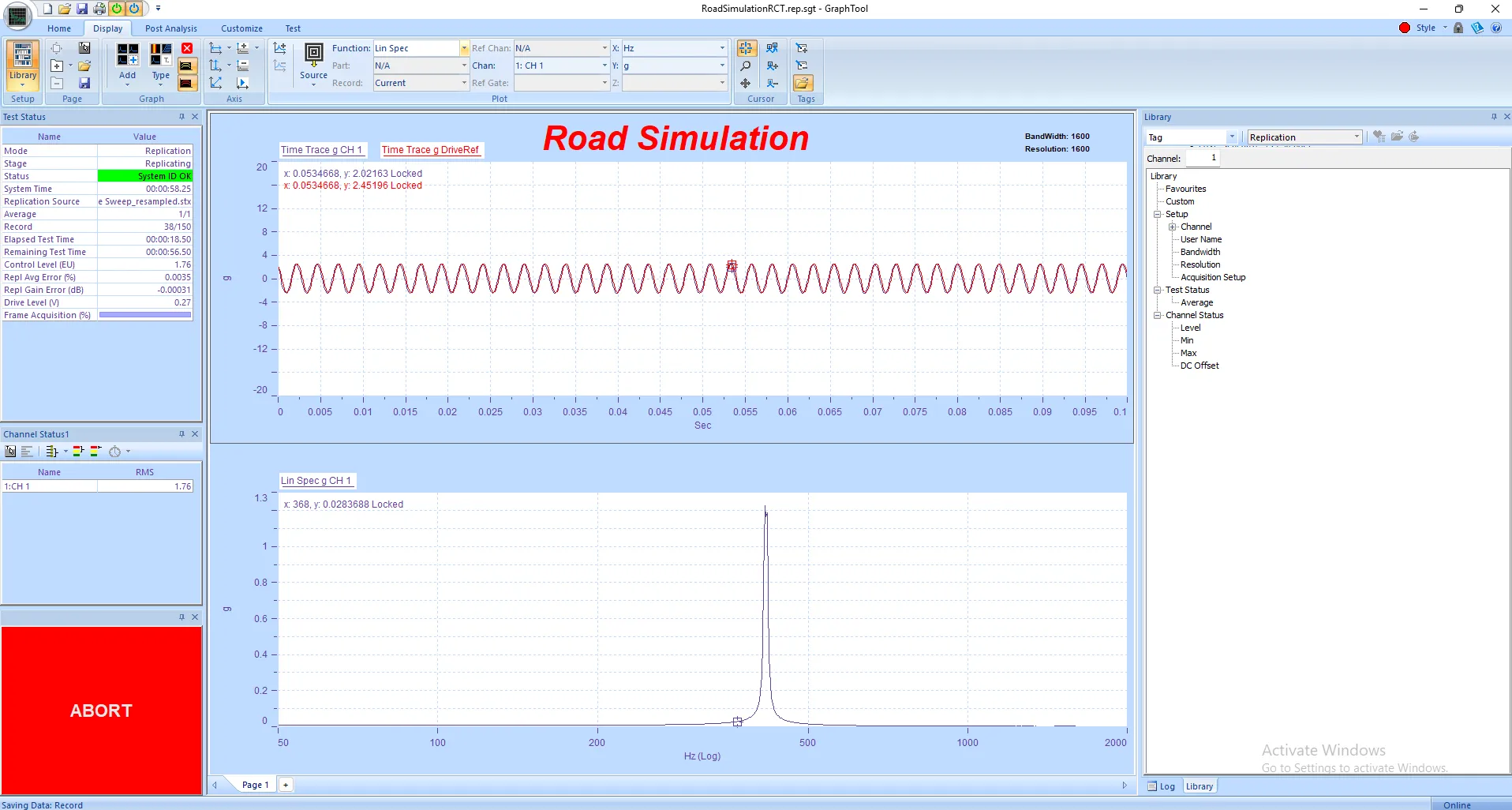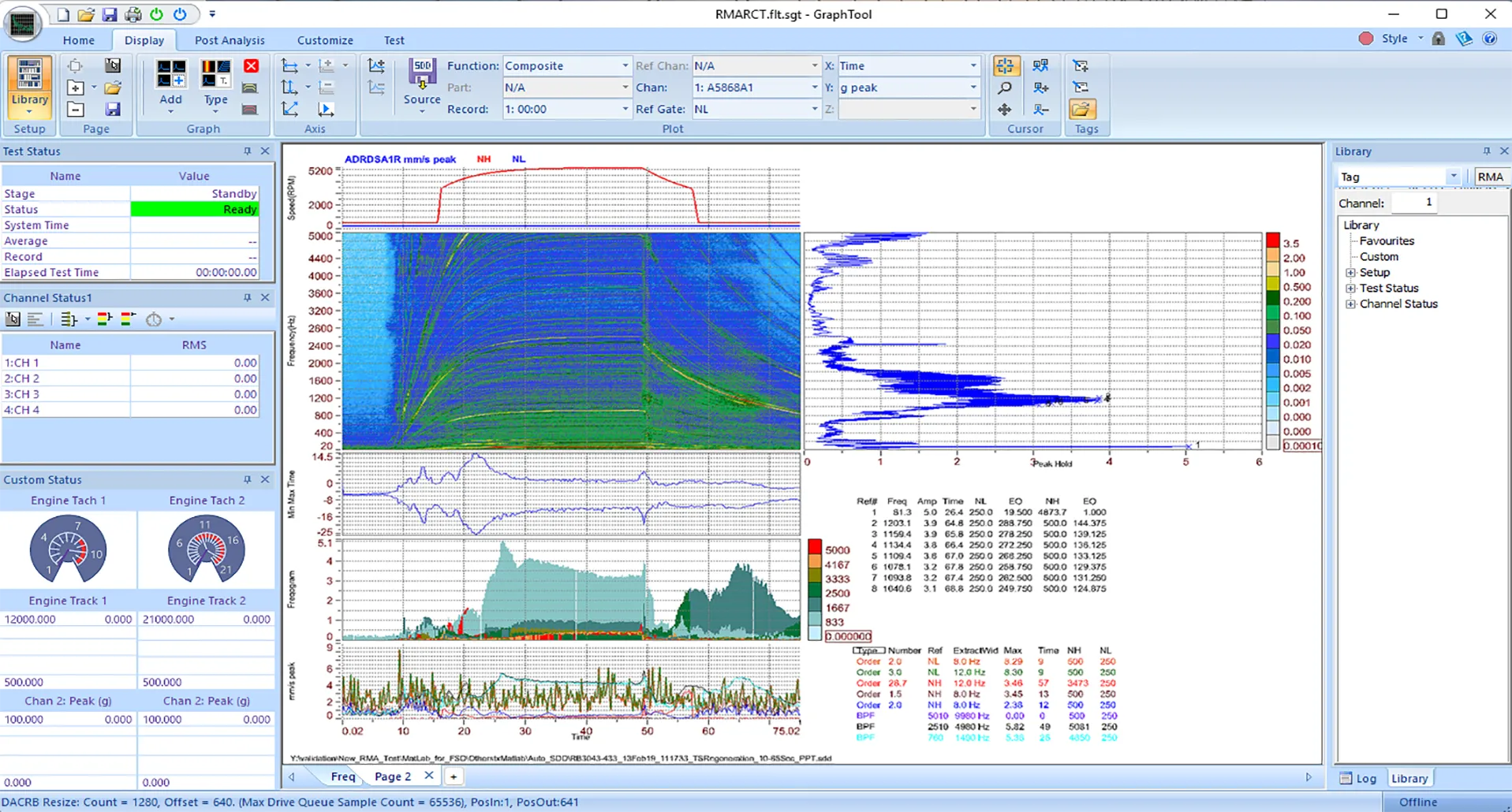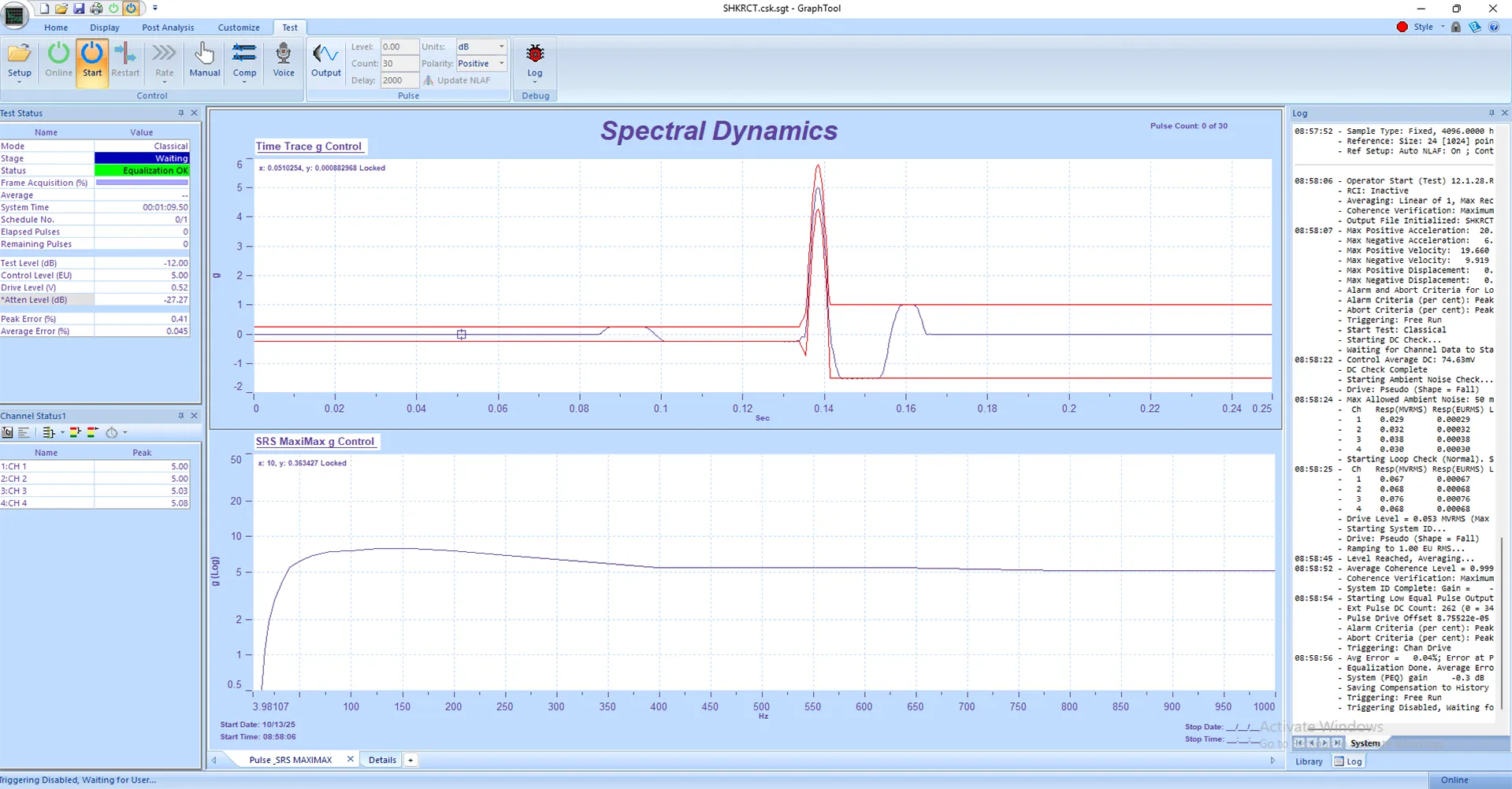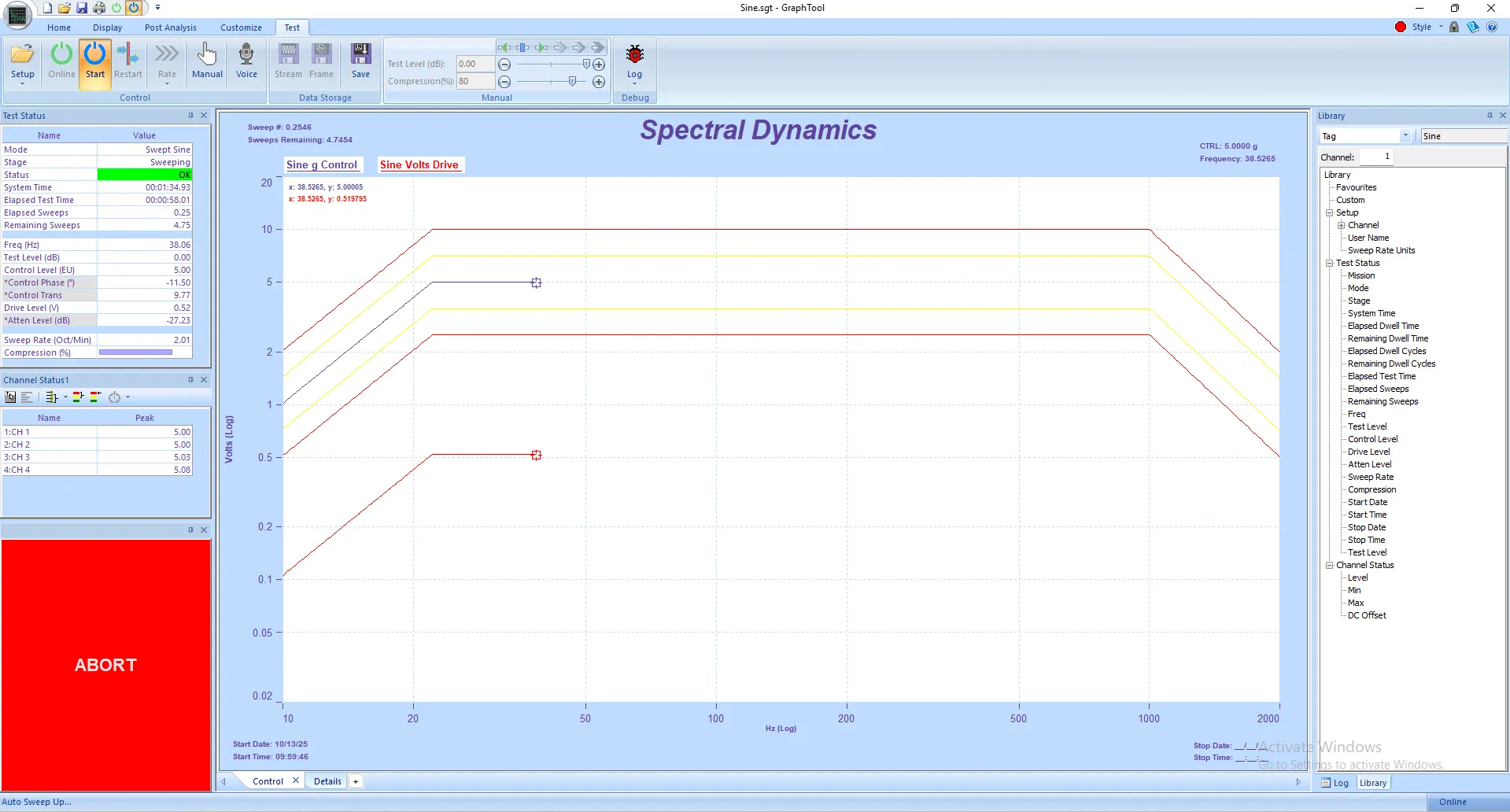Industry-Leading Gap-Free Data Streaming in Every Vibration Control Application
Panther's gap-free stream to disk capability represents a fundamental architectural advantage in vibration testing and data acquisition. Unlike competing vibration controllers that limit continuous data streaming to specific analysis modules or require complex configurations, Panther integrates this capability seamlessly into Random vibration testing, Sine vibration control, Shock testing, RMA (Rotating Machinery Analysis), Sine-on-Random, Random-on-Random, and all other control applications.
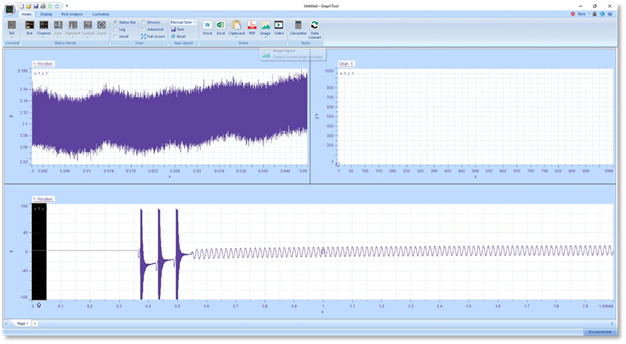
This universal availability means engineers conducting any vibration test can capture complete, continuous time-domain data directly to the host disk without interruption—essential for regulatory compliance, failure analysis, post-test validation, and complete test traceability where every data point matters. Whether performing environmental testing, qualification testing, accelerated life testing, or production screening, Panther's streaming architecture ensures zero data loss throughout the entire test duration.
Multiple Independent Data Streams: Unique Panther Capability for Optimized Vibration Data Acquisition
Beyond simple continuous vibration data recording, Panther offers an exclusive capability found nowhere else in the vibration testing industry: multiple concurrent data streams, each with independent sample rates. This architectural innovation allows simultaneous acquisition of high-frequency and low-frequency signals without compromise—a critical advantage for multi-channel vibration testing and complex test setups.
For example, during a Random vibration control test, engineers can configure Panther to stream:
- Primary control channels at 25.6 kHz for precise high-frequency capture and accurate spectral control
- Response monitoring channels at 6.4 kHz for critical resonance tracking and transmissibility measurement
- Low-frequency strain gauges at 1.6 kHz for structural response monitoring and stress analysis
- Temperature sensors at 100 Hz for thermal monitoring and environmental chamber verification
All streams record simultaneously and continuously to disk with perfect time synchronization—no data gaps, no compromises in sample rate selection, and no need to choose between high-frequency accuracy and efficient data storage. This multiple sample rate streaming capability is unique to Panther and represents a significant competitive advantage over systems that force all channels to share a single sample rate.
Hours of Uninterrupted Vibration Test Data Recording Without Data Loss
Panther's continuous data streaming architecture leverages high-speed USB and Ethernet interfaces combined with efficient hardware buffering algorithms to ensure uninterrupted recording for extended test durations. Whether conducting:
- Long-duration Random vibration testing (multi-hour qualification runs per MIL-STD-810, DO-160, or ISO 16750 requirements)
- Extended Sine sweep testing with detailed resonance characterization and frequency response measurement
- Rotating Machinery run-up/coast-down analysis capturing transient behavior, order tracking, and Campbell diagram data
- Multi-sequence Shock testing with complete inter-event data for pulse verification and system response analysis
- Environmental stress screening (ESS) requiring full traceability for quality records and compliance documentation
- Accelerated life testing with continuous monitoring for failure detection and root cause analysis
...Panther records every sample without interruption. The system maintains continuous gap-free streaming even during high-demand operations, eliminating the frustrating data gaps that plague other vibration control systems when buffer overruns occur. This reliability is critical for aerospace testing, automotive qualification, defense applications, and any situation where missing even milliseconds of data can invalidate test results or obscure critical failure events.
Intuitive Multi-Run Data Playback and Comparison for Vibration Test Analysis
Panther's stream to disk functionality extends beyond acquisition. The system provides intuitive replay capabilities allowing engineers to overlay and compare streamed data from multiple test runs in a single graph—a vibration data visualization feature unique to Panther that dramatically simplifies:
- Test-to-test repeatability verification for production testing and quality assurance
- Before/after modification comparisons for design optimization and fixture improvement
- Fixture resonance correlation studies for shaker table characterization and test setup validation
- Control algorithm optimization by comparing different control parameters and drive strategies
- Failure event analysis with reference baseline overlays to identify anomalies and failure precursors
- System transfer function measurement across multiple configurations or test articles
This single-graph comparison capability eliminates the tedious process of exporting data to third-party analysis tools like MATLAB or Python, saving engineers valuable time while maintaining complete data integrity. All playback and comparison operations occur within the native GTX software environment, ensuring seamless workflow integration.
Complete Test Traceability for Regulatory Compliance and Quality Documentation
Regulatory standards across aerospace (MIL-STD-810, MIL-STD-202, DO-160), automotive (ISO 16750, SAE J2380, USCAR), and defense applications (MIL-STD-883, DEF-STAN) increasingly require complete vibration test data documentation. Panther's universal continuous streaming capability ensures:
- Full waveform capture for every test, every channel, every time—no sampling, no gaps, no compromises
- High-precision time-stamped recordings with millisecond accuracy for event correlation and failure forensics
- Synchronized multi-channel data acquisition maintaining phase relationships critical for modal analysis and transfer function measurement
- Efficient binary file formats optimized for storage efficiency, rapid retrieval, and long-term archival
- Automated file management through Panther's Library system with searchable metadata and instant recall
- NIST-traceable calibration data embedded in all recordings for measurement validation and audit compliance
When audit questions arise months or years after testing, having gap-free recordings of actual vibration test data—not just calculated summary statistics—provides definitive answers. This complete traceability is invaluable for product liability defense, warranty claim investigation, certification maintenance, and design validation documentation.
Technical Architecture Enabling Continuous Gap-Free Vibration Data Streaming
Panther achieves uninterrupted continuous data streaming through several integrated architectural elements that distinguish it from competitive vibration test controllers:
24-Bit ADC Resolution with Greater Than 110 dB Dynamic Range
High-resolution data acquisition with 24-bit analog-to-digital converters captures subtle signal variations without quantization artifacts, ensuring recorded data accurately represents actual test conditions across the full amplitude range from noise floor to peak levels. This exceptional dynamic range exceeds industry standards and provides superior signal fidelity compared to systems using 16-bit or 18-bit ADCs. The >110 dB dynamic range specification represents honest, achievable performance rather than theoretical maximums that ignore real-world limitations like ENOB (Effective Number of Bits), filter losses, and environmental noise.
True Simultaneous Sampling on All Input Channels
True simultaneous sampling at up to 262,144 samples per second across all input channels (expandable from 8 to 32 channels) maintains perfect phase relationships—critical for modal analysis, transfer function measurement, multi-axis vibration testing, and MIMO (Multiple Input Multiple Output) control applications. Unlike sequential sampling systems that introduce phase errors between channels, Panther's simultaneous architecture ensures all channels are digitized at precisely the same instant, enabling accurate correlation studies and phase-sensitive measurements.
Hardware-Based Data Buffering with FPGA and DSP Processors
Onboard FPGA (Field-Programmable Gate Array) and DSP (Digital Signal Processor) processors implement multi-stage buffering that decouples real-time acquisition from host disk write operations. This hardware architecture prevents buffer overruns even during momentary disk access delays, system resource contention, or network latency, ensuring continuous gap-free data streaming under all operating conditions. The distributed processing architecture scales with channel count, maintaining performance even in high-channel-count applications exceeding 100 channels.
Efficient Binary File Formats for Extended Recording Duration
Proprietary streaming file formats (STX, TSTX, STS) minimize storage overhead while maximizing write speed, allowing hours of multi-channel data capture without overwhelming modern SSD or hard drive systems. These formats maintain full 24-bit precision with synchronized timestamps and comprehensive metadata, enabling rapid post-test analysis without data conversion overhead. Binary efficiency means typical vibration test recordings consume approximately 3 GB per hour for 16 channels at 25.6 kHz—manageable on modern storage systems while preserving complete waveform fidelity.
Real-World Vibration Testing Applications Requiring Continuous Data Streaming
Rotating Machinery Diagnostics and Order Tracking Analysis
During RMA (Rotating Machinery Analysis) testing, capturing complete run-up and coast-down profiles reveals critical information about bearing health, rotor balance, gear mesh frequencies, and structural resonances. Panther's gap-free streaming capability ensures every rpm increment is recorded without missing transient events, enabling accurate order tracking, Campbell diagram generation, and waterfall plot analysis without interpolation artifacts. The dedicated 1 MHz hardware tachometer input provides precise speed measurement and phase synchronization even at the highest rotational rates, critical for vibration analysis of turbomachinery, compressors, generators, and high-speed rotating equipment.
Failure Mode Analysis and Root Cause Investigation
When components fail during accelerated life testing or environmental stress screening, having continuous vibration data leading up to the failure event is invaluable for root cause analysis. Panther's continuous streaming captures the complete failure progression—from initial anomaly through catastrophic event—without missing critical milliseconds due to data gaps or trigger delays. This complete record enables engineers to identify failure precursors, validate failure mechanisms, optimize design modifications, and defend design decisions with objective evidence. For aerospace qualification testing, automotive durability testing, and defense system validation, this capability can mean the difference between successful troubleshooting and expensive test repetition.
Modal Testing and High-Resolution Transfer Function Measurement
High-resolution transfer function measurements and experimental modal analysis require consistent signal quality throughout the test with no data gaps or discontinuities. Panther's continuous data streaming at independent sample rates per channel allows optimal acquisition settings for both excitation and response measurements, improving coherence, reducing measurement time, and enabling accurate identification of closely-spaced modes. The system supports both impact testing (hammer testing) and shaker-based modal testing with complete time history capture for post-processing using advanced modal parameter extraction algorithms including SDOF, MDOF, polyreference, and rational fraction polynomial methods.
Environmental Stress Screening for Production Quality Assurance
Production ESS (Environmental Stress Screening) programs demand verifiable proof that every unit received proper environmental exposure to precipitate latent defects. Panther's universal streaming capability documents complete test profiles for quality records, eliminating disputes about test adequacy, equipment malfunction, or operator error. The automated data archival through the Library system ensures every production unit has a permanent, traceable record linked to serial numbers and test parameters. This documentation is critical for AS9100 aerospace quality management, IATF 16949 automotive quality, and ISO 9001 certification maintenance.
Shock Pulse Verification and SRS Synthesis Validation
Classical shock testing and SRS (Shock Response Spectrum) synthesis benefit from complete waveform recording before, during, and after each pulse. Panther captures all events without triggering complexity, ensuring engineers can verify pre-pulse quiescence, pulse shape accuracy, peak acceleration achievement, pulse duration precision, and post-pulse fixture ringing. For SRS synthesis applications, the continuous recording validates that synthesized waveforms match target spectra across all Q values and frequencies, enabling confident testing to MIL-STD-810 Method 516, MIL-STD-883 Method 2002, NATO AECTP-400, and other shock test standards.
Satellite Qualification and Spacecraft Vibration Testing
Satellite vibration testing represents one of the most demanding applications for gap-free data recording. Pre-launch qualification requires complete documentation of all sine sweep tests, random vibration tests, and acoustic testing with no missing data that could void certification or mask potential problems. Panther's streaming capability captures every aspect of these critical tests, from initial low-level surveys through full-qualification runs, providing the documentation required by NASA, ESA, JAXA, and commercial launch providers. The ability to record at multiple sample rates simultaneously is particularly valuable when monitoring both primary structure response (high frequency) and secondary payloads or solar panels (lower frequency) during the same test.
Comparison with Competitive Vibration Controller Limitations
Most vibration controllers in the market impose significant restrictions on continuous data recording and streaming capabilities:
- Streaming limited to analysis packages only – Random, Sine, and Shock control applications cannot stream continuously, requiring separate data acquisition systems
- Fixed sample rate requirements – All channels must share the same rate, forcing suboptimal compromises between high-frequency accuracy and storage efficiency
- Duration limitations – Arbitrary recording time limits (often 10-30 minutes) or file size restrictions that interrupt long tests
- Buffer overruns during high-demand tests – Data gaps occur when acquisition overwhelms storage subsystem, particularly common with high channel counts
- Complex configuration procedures – Streaming requires specialized setup outside normal test definitions, increasing setup time and operator training requirements
- No integrated playback tools – Recorded data must be exported to third-party software (MATLAB, Python, Excel) for analysis and comparison
- Poor PC crash recovery – Loss of host computer connection results in lost data rather than graceful test continuation or safe ramp-down
- Separate licensing costs – Many systems charge extra for streaming capabilities or limit streaming to premium software packages
Panther eliminates every one of these limitations, providing seamless, gap-free continuous streaming as a standard capability across the entire application suite. This comprehensive approach means engineers never need to compromise between control quality and data completeness—both are provided simultaneously without configuration complexity or performance degradation.
Seamless Integration with GTX Software Environment and Panther Library
All streaming functionality integrates naturally within Spectral Dynamics' GTX software framework. Engineers configure streaming parameters alongside other test settings using intuitive dialog boxes, eliminating the need to switch between control and analysis modes or launch separate data acquisition applications. The Panther Library system provides instant access to all streamed data files with searchable metadata including:
- Test article identification and serial number tracking
- Test type and profile parameters (Random PSD, Sine sweep range, Shock pulse type)
- Operator name and date/time stamps for quality traceability
- Channel configuration and sensor calibration data for measurement validation
- Custom tags and notes for project organization and retrieval
This comprehensive organization enables rapid comparisons between current tests and historical baselines without navigating complex Windows directory structures or remembering cryptic file naming conventions. The GTX interface supports full touch-screen operation on Windows PCs and Microsoft Surface devices, making streaming configuration accessible even in laboratory environments where keyboard access is impractical due to gloves, cleanliness requirements, or space constraints.
Storage Considerations and Best Practices for Vibration Test Data Recording
While Panther handles the technical challenges of continuous gap-free streaming, engineers should consider storage planning for optimal system performance:
- Disk space requirements scale with channel count, sample rate, and test duration – a typical 16-channel test at 25.6 kHz generates approximately 3 GB per hour (72 GB per 24-hour test)
- SSD (Solid State Drive) storage provides optimal performance for high-channel-count, high-sample-rate applications, eliminating mechanical seek delays
- Network storage (NAS/SAN) works well for moderate data rates but may require bandwidth validation for demanding applications exceeding 100 MB/s write speeds
- RAID configurations can provide both performance enhancement and data redundancy for mission-critical testing where data loss is unacceptable
- Automated archival strategies help manage long-term storage requirements, moving completed test data to secondary storage while maintaining active test data on high-speed drives
- Data retention policies should balance regulatory requirements (often 7-10 years for aerospace/defense) with storage costs and retrieval needs
Panther's flexible architecture supports direct-attached storage (DAS), network shares (SMB/CIFS), removable media, and cloud-connected archival systems, allowing engineers to optimize the storage topology for their specific workflow requirements. The system automatically manages buffer allocation and write prioritization to ensure control loop performance is never compromised by data recording operations.
Summary: Stream to Disk as a Competitive Differentiator in Vibration Testing
Panther's stream to disk capability represents more than a feature—it's an architectural philosophy prioritizing complete data integrity and operational flexibility across all vibration testing applications. By offering:
- Gap-free continuous streaming in every application (Random, Sine, Shock, RMA, SOR, ROR), not just analysis modes
- Multiple independent data streams with optimized sample rates per channel—exclusive to Panther
- Hours of uninterrupted recording without buffer overruns, data loss, or performance degradation
- Intuitive multi-run playback and comparison within the native GTX interface
- Seamless integration with all control modes requiring no special configuration or separate software licenses
- Complete regulatory compliance documentation for aerospace, automotive, defense, and commercial standards
- Superior 24-bit ADC performance with >110 dB honest dynamic range specification
- Hardware-based buffering ensuring zero data loss even during system resource contention
...Panther enables engineers to trust their vibration test data completely. When test results are questioned, when failures need forensic analysis, when regulatory compliance demands documentation, when scientific rigor requires complete datasets, or when design validation depends on objective evidence—Panther's continuous streaming architecture delivers the proof that matters.
Other vibration control systems ask you to choose between control precision and data completeness. Panther gives you both—simultaneously, reliably, and without compromise.
Does Panther's gap-free stream to disk work in all vibration control applications or just analysis modes?
Panther provides gap-free stream to disk capability across all vibration control applications including Random vibration testing, Sine vibration control, Shock testing, RMA (Rotating Machinery Analysis), Sine-on-Random, Random-on-Random, and others—not just in analysis packages. This universal availability eliminates the need to switch between control and analysis modes to capture continuous data, and distinguishes Panther from competitive systems that limit streaming to specific software modules. Engineers can configure continuous data recording as part of the standard test setup for any application without special procedures or separate data acquisition hardware.
Can different channels stream at different sample rates simultaneously in Panther?
Yes. Panther uniquely supports multiple concurrent data streams with independent sample rates—an exclusive capability not available in competing vibration control systems. Engineers can simultaneously stream control channels at high rates (25.6 kHz), response channels at moderate rates (6.4 kHz), and auxiliary sensors at lower rates (100 Hz) without compromise. This multiple sample rate streaming capability optimizes both data quality and storage efficiency, allowing high-frequency accuracy where needed while avoiding unnecessary data volume on low-bandwidth channels. Each stream maintains perfect time synchronization and records gap-free to the host disk.
How long can Panther stream vibration test data continuously without data gaps?
Panther supports continuous gap-free streaming for hours at a time, limited only by available disk storage rather than system architecture or buffer limitations. The high-speed data path with hardware-based FPGA/DSP buffering prevents buffer overruns even during extended high-sample-rate testing with high channel counts, ensuring complete data integrity throughout long-duration qualification tests. Typical applications include multi-hour Random vibration testing per MIL-STD-810, extended Sine sweeps for resonance characterization, and all-day ESS production screening runs. The system maintains uninterrupted recording even during momentary disk access delays or system resource contention.
Can streamed vibration data from multiple test runs be compared directly in Panther?
Yes. Panther includes unique playback and comparison capabilities allowing engineers to overlay streamed data from multiple runs in a single graph within the native GTX software interface. This intuitive visualization dramatically simplifies test-to-test repeatability verification, before/after modification comparisons, and failure event analysis without requiring data export to third-party tools like MATLAB or Python. Engineers can rapidly compare control channels, response measurements, or calculated parameters across different test runs, fixture configurations, or test articles. The comparison tools maintain full time-base correlation and support overlay, difference, and ratio calculations for detailed analysis.
Does continuous data streaming require special configuration or affect vibration control quality?
No special configuration is required—streaming integrates seamlessly into standard test setup procedures through simple dialog box selections in the GTX software. The hardware architecture with onboard FPGA and DSP processors decouples real-time control from data recording operations, ensuring streaming has zero impact on control loop performance, safety monitoring, or system responsiveness. Control update rates, abort reaction times, and closed-loop accuracy remain identical whether streaming is enabled or disabled. Engineers get both precise vibration control and complete data capture simultaneously without performance trade-offs or configuration complexity.
What file formats does Panther use for streamed vibration test data?
Panther uses optimized binary file formats (including STX, TSTX, and STS formats) that maximize write speed while minimizing storage overhead. These proprietary formats maintain full 24-bit precision of the ADC data with synchronized timestamps, channel metadata, calibration constants, and test parameters. The efficient binary structure enables rapid post-test analysis without format conversion overhead. The Panther Library system provides instant access to all recorded files for playback, analysis, comparison, or export to universal formats (CSV, MATLAB, UFF) when needed for third-party processing. Data integrity is protected through checksums and header validation.
How much disk space is needed for extended vibration test streaming?
Storage requirements depend on channel count, sample rate, and test duration. As a reference, a 16-channel test streaming at 25.6 kHz generates approximately 3 GB per hour (72 GB for a 24-hour test). The binary format efficiency means most vibration testing applications require manageable storage on modern SSD or hard drive systems. Panther supports direct-attached storage (SSD/HDD), network shares (NAS/SAN), and removable media, allowing engineers to optimize storage topology based on specific workflow requirements. SSD storage provides optimal performance for high-channel-count applications, while network storage works well for moderate data rates. Automated archival to secondary storage enables unlimited recording duration for production testing or long-term monitoring applications.
Is gap-free streamed data suitable for regulatory compliance and aerospace/automotive quality documentation?
Yes. Panther's gap-free continuous streaming provides complete test data documentation meeting requirements for aerospace standards (MIL-STD-810, MIL-STD-202, DO-160, NASA specifications), automotive standards (ISO 16750, SAE J2380, USCAR requirements), and defense regulations (MIL-STD-883, DEF-STAN). Time-stamped recordings with millisecond precision, synchronized multi-channel capture maintaining phase relationships, and binary formats optimized for long-term archival ensure engineers have definitive evidence for audit responses and validation questions years after testing. The complete waveform records (not just summary statistics) provide proof of proper test execution, enable failure forensics, support product liability defense, and satisfy certification maintenance requirements for AS9100, IATF 16949, and ISO 9001 quality management systems.
What makes Panther's stream to disk capability better than competitive vibration controllers?
Panther's stream to disk capability surpasses competitive systems in multiple critical ways: (1) Universal availability across all control applications not just analysis packages, (2) Multiple independent data streams with different sample rates—unique to Panther, (3) Unlimited duration recording without arbitrary time limits, (4) Zero buffer overruns due to hardware-based buffering architecture, (5) No special configuration required—streaming integrates into normal test setup, (6) Integrated playback and comparison tools eliminating third-party software requirements, (7) No impact on control performance due to distributed processing architecture, and (8) Standard capability included without premium licensing costs. These advantages mean engineers never need to choose between control quality and data completeness—Panther provides both simultaneously.
Can Panther stream data during MIMO multi-shaker vibration testing?
Yes. Panther's gap-free streaming capability works seamlessly during MIMO (Multiple Input Multiple Output) multi-shaker control testing including 3-axis, 6-DOF, and custom multi-axis configurations. All control channels, response channels, and drive outputs stream continuously with perfect time synchronization across the entire shaker array. This capability is critical for aerospace multi-axis testing, automotive durability testing, and large structure testing where understanding the correlation between multiple shaker inputs and structural response requires complete time-history data. The multiple independent sample rate capability is particularly valuable in MIMO applications where different measurement locations may require different bandwidths (high-frequency primary structure vs. low-frequency secondary appendages).

